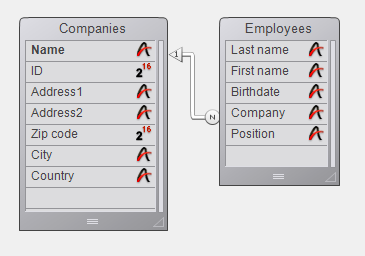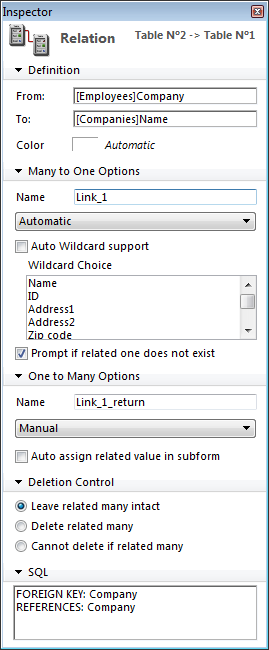4D v13.4
GET FIELD RELATION
 GET FIELD RELATION
GET FIELD RELATION
| GET FIELD RELATION ( manyField ; one ; many {; *} ) | ||||||||
| Parameter | Type | Description | ||||||
| manyField | Field |

|
Starting field of a relation | |||||
| one | Longint |

|
Status of the Many-to-One relation | |||||
| many | Longint |

|
Status of the One-to-Many relation | |||||
| * | Operator |

|
• If passed: one and many return the current status of the relation (values 2 or 3 only) • If omitted (default): one and many can return the value 1 if the relation has not been modified through programming | |||||
The GET FIELD RELATION command lets you find out the automatic/manual status of the relation starting from manyField for the current process. You can view any relation, including automatic relations set in the Structure window.
- In manyField, pass the name of theMany table field from which the relation whose status you want to find out originates. If no relation originates from the manyField field, the one et many parameters return 0, an error is returned and the system variable OK is set to 0 (see below).
- After the command is executed, the one parameter contains a value indicating whether the Many-to-One relation specified is set as automatic:
0 = There is no relation originating from manyField. Syntax error No. 16 (“The field has no relation”) is generated and the system variable OK is set to 0.
1 = The automatic/manual status of the Many-to-One relation specified is that set by the Auto Relate One option in the Relation properties of the Design environment (it has not been modified by programming).
2 = The Many-to-One relation is manual for the process.
3 = The Many-to-One relation is automatic for the process. - After the command is executed, the many parameter contains a value indicating whether the One-to-Many relation specified is set as automatic:
0 = There is no relation originating from manyField. Syntax error No. 16 (“The field has no relation”) is generated and the system variable OK is set to 0.
1 = The automatic/manual status of the One-to-Many relation specified is that set by the Auto One to Many option in the Relation properties of the Design environment (it has not been modified by programming).
2 = The One-to-Many relation is manual for the process.
3 = The One-to-Many relation is automatic for the process.
You can compare the values returned in the one and many parameters with the constants of the “Relations” theme:
| Constant | Type | Value |
| Automatic | Longint | 3 |
| Manual | Longint | 2 |
| No relation | Longint | 0 |
| Structure configuration | Longint | 1 |
Given the following structure:

The properties of the relation linking the [Employees]Company field to the [Companies]Name field are the following:

The following code illustrates the various possibilities offered by the GET FIELD RELATION, GET AUTOMATIC RELATIONS and SET FIELD RELATION, SET AUTOMATIC RELATIONS commands along with their effects:
GET AUTOMATIC RELATIONS(one;many) `returns False, False
GET FIELD RELATION([Employees]Company;one;many) `returns 1,1
GET FIELD RELATION([Employees]Company;one;many;*) `returns 3,2
SET FIELD RELATION([Employees]Company;2;0) `changes Many-to-One relation to manual
GET FIELD RELATION([Employees]Company;one;many) `returns 2,1
GET FIELD RELATION([Employees]Company;one;many;*) `returns 2, 2
SET FIELD RELATION([Employees]Company;1;0) `re-establishes the parameters set in Design environment for Many-to-One relation
GET FIELD RELATION([Employees]Company;one;many) `returns 1,1
GET FIELD RELATION([Employees]Company;one;many;*) `returns 3,2
SET AUTOMATIC RELATIONS(True;True) `changes all relations of all tables to automatic
GET AUTOMATIC RELATIONS(one;many) `returns True, True
GET FIELD RELATION([Employees]Company;one;many) `returns 1,1
GET FIELD RELATION([Employees]Company;one;many;*) `returns 3,3
Product: 4D
Theme: Relations
Number:
920
Created: 4D 2004
GET AUTOMATIC RELATIONS
GET RELATION PROPERTIES
SET AUTOMATIC RELATIONS
SET FIELD RELATION








